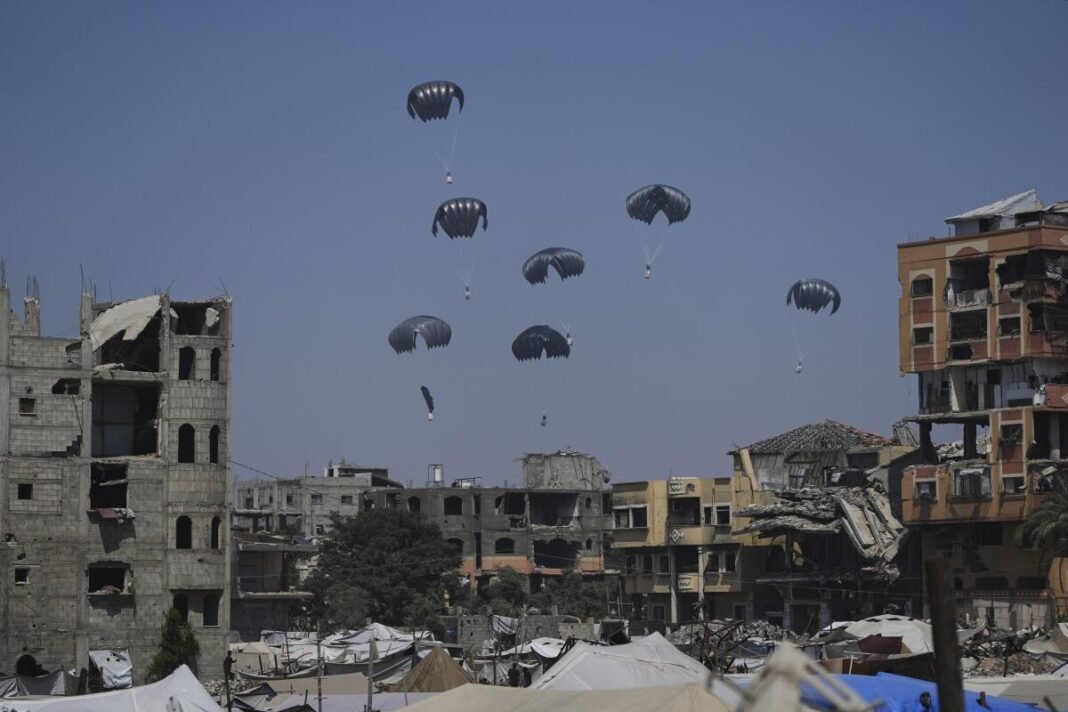Israel, Six Nations Airdrop Humanitarian Aid into Gaza
In a rare coordinated humanitarian mission, the Israel Defense Forces (IDF) partnered with six other nations to air-drop food packages into the Gaza Strip, as reports of worsening humanitarian conditions continue to draw international attention. According to the Jerusalem Post, the operation marked the first multi-national aid drop in months and involved contributions from the United Arab Emirates, Jordan, Egypt, Spain, France, and Germany.
On Friday, the IDF stated that a total of 126 aid packages were delivered to both southern and northern Gaza. The airdrop was aimed at easing the plight of civilians amid ongoing hostilities and restricted access to essential supplies. This marked the first time that Israel coordinated such an operation with three European nations, highlighting a broader international push to alleviate the crisis.
Renewed International Efforts Amidst Growing Criticism
The move follows an earlier effort on July 27, when Jordan and the UAE dropped 25 tons of humanitarian aid into Gaza—the first airdrop in several months. That initiative appeared to set the stage for broader international involvement, culminating in this larger, multi-national undertaking.
The airdrops come at a time when Israel faces increasing scrutiny over the humanitarian situation in Gaza. Numerous global human rights organizations and foreign governments have voiced concerns about the accessibility of food, water, and medical supplies for Gaza’s civilian population.
IDF Denies Starvation Allegations
Amid mounting pressure, IDF Chief of Staff Lt. Gen. Eyal Zamir firmly denied accusations that Israel is using starvation as a weapon of war. Addressing the allegations, Zamir said, “These are deceitful and coordinated attempts to falsely accuse the IDF of war crimes.” He insisted that Israeli forces operate in compliance with international law and uphold moral standards in the conduct of their military operations.
He also reiterated that the suffering endured by Gaza’s residents stems from the actions of Hamas, not the IDF. “The party responsible for the killing and suffering of Gaza’s residents is Hamas,” Zamir emphasized.
Hostage Talks and Military Strategy
Lt. Gen. Zamir also provided an update on hostage negotiations, stating that ongoing military operations would not be halted, even if a partial agreement were reached. He noted that the coming days would be critical in determining whether such a deal might materialize. However, in the absence of any breakthrough, Israeli military operations would continue unabated.
While Gaza remains a key focus, Zamir also outlined developments on Israel’s northern front. Despite a ceasefire agreement reached in November 2024, the IDF has conducted numerous strikes targeting Hezbollah positions in Lebanon. According to military assessments, Hezbollah’s combat capability has been significantly diminished, with its arsenal of 150,000 rockets and numerous launch systems now reduced to a mere fraction.
Syria’s Role and Regional Dynamics
The new Sunni-led regime in Syria has reportedly taken steps to restrict Iranian arms transfers to Hezbollah, a move that the IDF believes has further weakened the group’s operational capabilities. Israel has also carried out multiple airstrikes on strategic positions along the Syria-Lebanon border in efforts to curtail Hezbollah’s regional influence.
Since the ceasefire, the IDF has launched more than 500 precision strikes against Hezbollah targets, contributing to what it claims is a substantial reduction in the risk of a large-scale ground invasion. While sporadic attacks may still occur, the IDF now views Hezbollah as a significantly less potent threat.
Humanitarian Relief Amid Conflict
The latest airdrop into Gaza underscores the international community’s growing concern over civilian suffering and highlights efforts to balance humanitarian assistance with ongoing military operations. Although Israel continues to maintain a firm stance on its military strategy and denies any intent to inflict widespread civilian harm, the pressure to address humanitarian needs is unlikely to subside.
As both the military and diplomatic landscapes evolve, such coordinated relief missions may become more critical in mitigating civilian harm and stabilizing the region.








